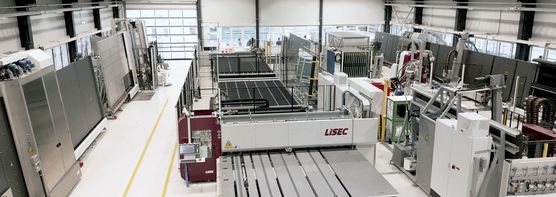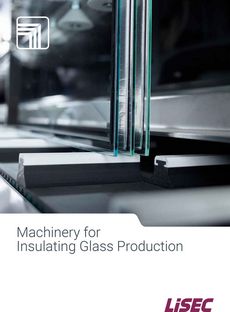
Systems & Lines
Insulating Glass Line for Thermoplastic Spacers
- LiSEC
- Systems & Lines
- Insulating Glass Line for Thermoplastic Spacers
- Insulating glass line for thermoplastic spacers
Insulating glass line for thermoplastic spacers
This line is the result of consistent further development based on quality and flexibility. This line sets new standards in the processing of thermoplastic spacers. It combines gas-tightness of the units with simultaneous adherence to minimum manufacturing tolerances and therefore satisfies the constantly increasing requirements placed on insulating glass manufacturers. A wide range of unit thicknesses can be processed and set-up times are short. This leads to optimised production, because a number of production steps - for example frame production, logistics and frame storage, etc. - are superfluous.
HOW IS THE INSULATING GLASS LINE STRUCTURED?
This insulating glass line consists of a six-brush washing machine, a quality scanner, a frame setting and inspection station, a TPA applicator for thermoplastic spacers, an assembling and gas filling press, and a sealing machine.
HOW DOES THE INSULATING GLASS LINE FOR THERMOPLASTIC SPACERS WORK?
The glass sheets are thoroughly cleaned and then dried in the washing machine. The glass lites sheets are inspected at the downstream frame mounting station, and it is possible to set rigid spacers manually. The spacer bar strand is then automatically applied to the TPA and the sealing point is pressed. The spacer width can be steplessly changed without interruption. The gas filling press takes care of the assembly, the gas filling process and the pressing of the insulating glass units. At the end of the line, sealing ensures the necessary stability and, above all, perfect corners.
FOR WHOM IS THE INSULATING GLASS LINE SUITABLE?
The insulating glass line for thermoplastic spacers is ideal for companies that require a rapid cycle time and a high degree of automation. This system is also the first choice when producing custom shapes.
WHAT ADVANTAGES DOES THE SYSTEM OFFER?
The washing machine with up to eight brushes and two hot water zones ensures perfect washing results. Damage and scratches in the glass can be detected in the shortest possible time thanks to the optimum lighting at the inspection station. This insulating glass line impresses with a very high degree of automation. The bending, cutting and filling of rigid spacers is eliminated by the direct application of a thermoplastic strand that serves as a spacer. The thermoplastic spacer system provides a warm edge in the insulating glass due to its high thermal insulation. The assembly and gas filling press not only reduces gas losses but also the cycle time.
- Production of double and triple insulating glass units with gas filling
- Automatic sealing of the edge seal
- Glass thicknesses of 2–26 mm
- Frame widths of 6-20 mm
- Unit thicknesses of up to 80 mm TPA / 100 mm rigid spacers
- Edge deletion (AKL-A or AKL-S)
- Seaming (KSR or KSD)
- Washing machine with eight brushes (VHW-F)
- Frame setting & inspection zone with assembly aid
- Cycle time optimised assembly for double presses
- Unit turner/rotating station upstream of sealing machine
- Automatic application of distancing cork pads (APKV)
- Second and third metering for several sealant materials (PU/PS/SI)
- Shapes according to catalogue and free shapes
- 3 side levels / step UK on request
- Quadruple-glazed insulating glass
The Highlights
- Systems & Lines
- Individual Machines
- Software
















